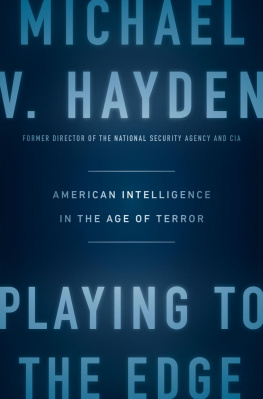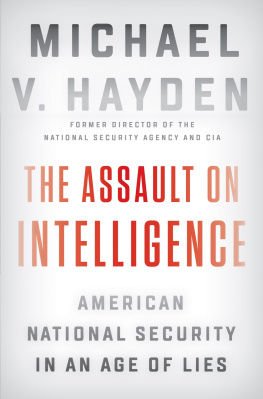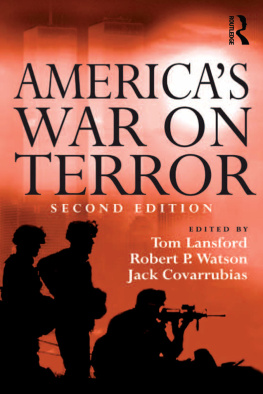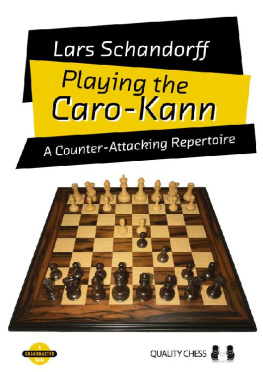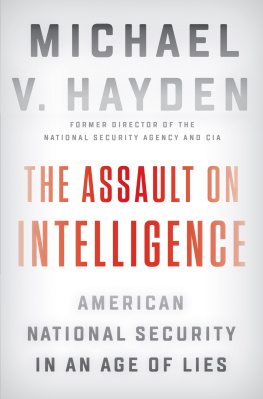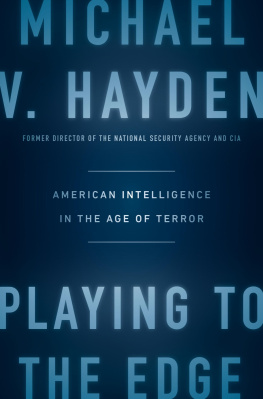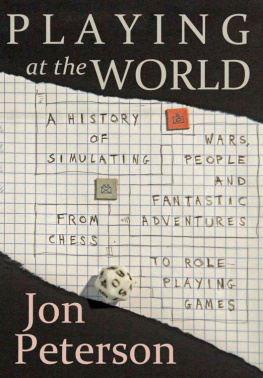Copyright 2016 by Michael V. Hayden
Penguin supports copyright. Copyright fuels creativity, encourages diverse voices, promotes free speech, and creates a vibrant culture. Thank you for buying an authorized edition of this book and for complying with copyright laws by not reproducing, scanning, or distributing any part of it in any form without permission. You are supporting writers and allowing Penguin to continue to publish books for every reader.
Names: Hayden, Michael V. (Michael Vincent), 1945
Title: Playing to the edge : American intelligence in the age of terror / Michael V. Hayden.
Description: New York : Penguin Press, 2016.
Identifiers: LCCN 2015044201 (print) | LCCN 2015049127 (ebook) | ISBN 9781594206566 (hardback) | ISBN 9780698196131 (ebook) Subjects: LCSH: Intelligence serviceUnited States. | National securityUnited States. | United States. Central Intelligence Agency. | United States. National Security Agency. | BISAC: BIOGRAPHY & AUTOBIOGRAPHY / Political. | POLITICAL SCIENCE / Political Freedom & Security / Intelligence. | HISTORY / United States / 21st Century.
This does not constitute an official release of U.S. Government information. All statements of fact, opinion, or analysis expressed are those of the author and do not reflect the official positions or views of the U.S. Government. Nothing in the contents should be construed as asserting or implying U.S. Government authentication of information endorsement of the authors views. This material has been reviewed solely for classification.
To my wife, Jeanine, who lived this as fully as I did, but who sacrificed more along the way
FOREWORD: WHY THIS BOOK?
I had just walked out into the glare of the hot sun of the Australian outback, made even more harsh by the darkened light and digital screens of the windowless operations floor I had just departed. I was in Pine Gap, almost in the middle of nowhere. When you land at the local airport and travel the short service road to the main highway, you are greeted by a road sign. The closest town, Alice Springs, is a little more than ten kilometers to the right. Go left and the next important landmark, the near-mystic and locally sacred Ayers Rock (Uluru), is 450 kilometers away.
As we shielded our eyes from the sun, I turned to my Australian counterpart and asked if he ever wanted to explain to his citizens, and especially to his critics, the quality of the work we had just witnessed inside the facility. Actually, I said something along the lines of Wouldnt you love to be able to show people exactly what we do? He quickly responded that he would.
Critics, observers, and just average citizens dont know as much about intelligence as they want or should. A goal of this book is to help address that.
Okay. We cant go to the outback, but we can go behind the scenes. These pages are my best effort to show to the American people what their intelligence services actually do on their behalf. No Jack Bauers or Jason Bournes here, though. Just hardworking and dedicated Americans whose labor deserves understanding, appreciation, and even occasional criticism. This is a memoir, so I have to tell the story through my eyes, but I hope those about whom I write see it as their story as well.
Of course, there are limits. Classification and such. Frankly, there are too many limits and that hurts the community I served and still love, and the republic it serves. But I have pushed as hard as prudence and the law (and CIAs Publications Review Board) allow.
Even with stops as an ROTC instructor and some stretches in policy, I can still rightly be described as a career intelligence officer: reading out satellite imagery as a lieutenant at Strategic Air Command headquarters; supporting B-52 operations in Southeast Asia from Guam; head of intelligence at a tactical fighter wing in Korea; an overt intelligence collector as air attach in Communist Bulgaria; chief of intelligence for US forces in Europe during the Balkan Wars; commander of the air forces intelligence arm based in Texas.
I enjoyed nearly every minute of those jobs, but this book is less about them than about the last ten years of my government service, the decade I spent at the national level as director of the National Security Agency (DIRNSA), the first principal deputy director of National Intelligence (PDDNI), and director of the Central Intelligence Agency (DCIA).
There were policy and international issues aplenty in those years (19992009), and most of them touched on and were touched by intelligence. Many are recounted here from the perspective I had from those positions. The narrative reflects the always important, but sometimes delicate, relationship between intelligence and the policy makers that it serves. Theres a healthy dose also of the even more delicate relationship with congressional oversight.
Theres a chapter or three on bureaucracy as well. After all, the budgets of the agencies I headed are measured in the billions of dollars, their personnel counts are in the tens of thousands, and their presence is global. Organization, budgets, and personnel decisions matter, not so much in their own right, but as enablers of performance and mission success. Getting the overall structure right has been a pursuit of American intelligence for more than a decade.
Anyone running a large organization will understand how limited the tools of a CEO or a commander or a director really are. He or she can move (or get more) money, move boxes on an organizational chart, change out people, and exhort and inspire. Thats just about the whole toolbox. Ive always found it difficult to actually finish reading a book on management or leadership, but Ive nonetheless laid out my experiences here.
Then theres the spooky stuffespionage, covert action, and the like. Theres a lot of that even if theres more to be told thats not tellable now. A lot of the spooky stuff is about terrorism, but NSA and CIA have global responsibilities, so other topics will appear as well.
The telling is largely chronological, starting with events at NSA and proceeding through the ODNI (Office of the Director of National Intelligence) and CIA. Once engaged on a topic, though, I sometimes play it forward and play it back. The chapter on cyber, for example, comes naturally during my time at NSA, but to tell the tale properly I have to begin in Texas in the 1990s and play it forward through my time at CIA and beyond. Theres some of that with detentions and interrogations too.
Since this is a memoir, its center of gravity is the past, which will perforce drag in issues like renditions, detentions, interrogations, and the badly mislabeled domestic surveillance program. But in the writing I was struck by how much my experiences pulled me toward the future, toward things like the cyber domain and its challenges, a domain of conflict and cooperation whose importance seems to grow by the hour.
And, perhaps even more important, I was pulled toward the challenge of the long-term relationship between American espionage and the American people in an era of shrinking trust in government and expanding global threats.
I could be accused of grading my own work, but I believe that despite our flaws, were actually pretty good at this spy stuff. We need to preserve that capacity. The world is not getting any safer, and espionage remains our first line of defense.

